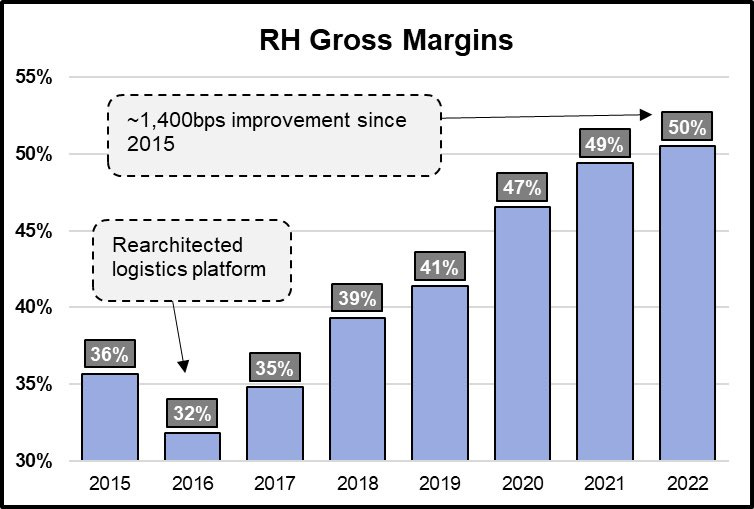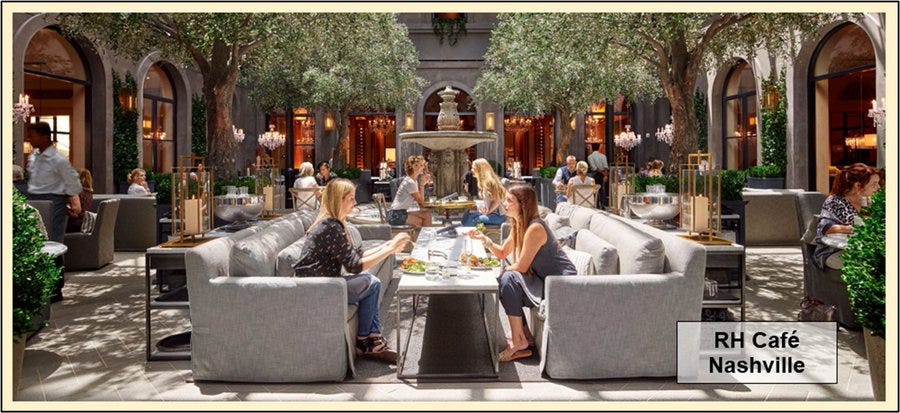RH 2022 Earnings Recap
Speedwell Research: Business Updates Series
We are going to periodically share updates on companies we have covered in the past here. These will sometimes show up as Twitter threads first, but we want readers to be able to easily access the archive of earnings recaps. The start here tab allows for easy navigation. We may occasionally refine or expand our analysis based on feedback.
This week, we’re covering RH. Last week, we covered Constellation Software.
RH 2022 Earnings Recap
RH recently reported 4Q22 results. We review their RY 2022 performance and provide a business update, high level investment thesis, and valuation commentary below.
Net revenues were -5% y/y to $3.6bn for 2022, but still up +36% since 2019. As a luxury furniture retailer, growth is lumpy but trends higher overtime. 2022 revenues are ~4.5x 2010. Growth has not been unit driven: their store count of 67 is lower than a decade ago.
Gross margins expanded 110bps y/y to 50.5%. Since 2015, gross margins have expanded ~1,400bps. Their margin profile is 5-10 points ahead of peers.
Opex grew +17% as they continue to open new Galleries. Their Gallery transformation is about half-way complete. Every time they swap a legacy gallery for the larger “Design Gallery”, sales double.
As they continue to transform their North America footprint, RH is also embarking on international expansion, starting with RH England, which is set to open in 2023.
RH believes 80% of their business could ultimately be outside of the US. They have set the ambitious target of >$20bn in international sales.
Now, if some of these goals seem far-fetched, a sense of history is in order. RH, or Restoration Hardware as it was then called, was once on the brink of bankruptcy and sold moon pies and dog biscuits. The average store brought in $2.4 million annually and lost money.
Today, they have over $2bn of cash, best-in-class operating margins that peaked at 25%, and generate $50mn/store on average. And no longer sell dog biscuits…but they did open up some of the world's most profitable restaurants in their stores.
As a seller of infrequently purchased, non-essential goods, they have to work to stay top of mind. The old RH solved for this by selling cheap tchotchkes to drive traffic. The new RH has high-end fine dining that serves as a customer acquisition tool (and is a profit center).
Gary Friedman may be “out there”, but you can’t deny his business acumen or work ethic. Raised by a single mother, he worked his way up The Gap and gained the attention of then CEO Mickey Drexler. Later he drove Williams-Sonoma’s Kitchen push, led Pottery Barn, and created West Elm.
Now, Friedman is now trying to re-envision how furniture is sold. Whereas competitors sell products, RH sells “spaces”. This is enabled by their in-house design services. Over 2/3rds of customers now use designers, which materially increases avg. spend per customer.
Whereas competitors use sporadic promotions to drive sales, RH architected a “membership” model where consumers pay $175 to buy at discounted member’s prices. This protects the brand while increasing a customer's commitment to buying RH.
However, make no mistake, this is a cyclical business.
RH guided 2023 revenues to be down 15-20%. Operating margins may compress a further 500bps from the 20.1% they did in 2022. Luxury home sales are down 45%.
But is that priced in?
The stock is down 70% from peak. Even taking the low end of guidance ($2.9bn in revenues) and not backing out growth expenses, that’s ~$300mn in NOPAT on a ~$6bn diluted market cap, implying a 20x multiple on macro-challenged earnings.
Forget the potentially larger international operation, the hotels, and many other initiatives. Let’s just look at North America.
The Gallery transformation alone implies at least $4.5bn in revenues. And RH now thinks they can do $5-6bn in total N.A. revenues.
Yes, margins will fluctuate with the economy, and some years will be worse than others. However, a 20% through-the-cycle margin seems very plausible (achieved 25% in 2021).
In the past, they actually said 20% would be a floor, they are now caveating that 20% would be the floor in a more “normal cycle”.
Frankly, it didn’t seem they conceived of how much luxury housing was whipsawed in the past two years. In the long-term though, Friedman thinks they will eventually be doing 30%+, like other luxury players.
Take just North America revenues with 20% margins and that yields $800-1bn in NOPAT. With 26.5mn diluted shares, that is $30-37 in EPS (3mn new shares under the 2023 stock incentive plan).
Pick a multiple, then look up the stock price. The difference is your return for holding over that time period (if assumptions hold).
As we’ve noted before, we prefer a reverse DCF. The exercise helps investors remember the relative unimportance of a couple of years of lower cash flows. Our reverse DCF showed cyclicality impacted returns just 1-2% annually.
In a wonderful business you can figure out what will happen. However, you can’t figure out when it will happen.
- Warren Buffett, Florida University Speech
Each investor must make their own judgment on whether the RH model resonates with consumers and if they can execute.
Our 80+ page report on RH can help investors get up to speed on the company much quicker though. Members Plus subscribers may also get access to and utilize our reverse DCF model to run different return scenarios.
If you liked this post, please share it so we know to post more content like this. Follow us on Twitter @Speedwell_LLC for more business and investing content!











nice post, one small mention is that that although they have $1.5b in cash, they do have debt of over $2b.